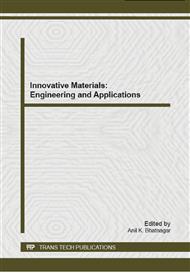[1]
Han L. C., Li E., GUO G. F. and Zheng H, in: Application of transmission/reflection method for permittivity measurement in coal desulfurization, Electromagnetics Research Letters, Vol. 37, 177-187, (2013).
DOI: 10.2528/pierl12123002
Google Scholar
[2]
D. J. Burr, in: Measurement of the complex dielectric constant from resonance in the radar cross section of a dielectric sphere, M. S. thesis, Dep. Elec. Eng., Univ. Urbana, (1971).
Google Scholar
[3]
D. Popovic, M. Okoniewski, in: Precision Open-Ended Coaxial Probe for Dielectric Spectroscopy of Breast Tissue, Antennas and Propagation Society International Symposium, vol. 1 p.815 – 818, (2002).
DOI: 10.1109/aps.2002.1016467
Google Scholar
[4]
EIJITANABE, WILLIAMT. JOINES, in: A Nondestructive Method for Measuring the Complex Permittivity of Dielectric Materials at Microwave Frequencies Using an Open Transmission Line Resonator, IEEE Trans. Inst. Meas., vol. IM-25, NO. 3, Sep. (1976).
DOI: 10.1109/tim.1976.6312350
Google Scholar
[5]
DEMING XU, LIPING LIU, AND ZHIYAN JIANG, in: Measurement of the Dielectric Properties of Biological Substances Using an Improved Open-Ended Coaxial Line Resonator Method, IEEE Trans. Micro. Theory Tech., vol. MTT-35, NO. 12, Dec. (1987).
DOI: 10.1109/tmtt.1987.1133870
Google Scholar
[6]
U. Raveendranath, S. Bijukumar, and K. T. Mathew, in: Broadband Coaxial Cavity Resonator for Complex Permittivity Measurements of Liquids, IEEE Trans. Inst. Meas., vol. 49, NO. 6, Dec. (2000).
DOI: 10.1109/19.893275
Google Scholar
[7]
C. Gao and X. –D. Xiang, in: Quantitative microwave near-field microscopy of dielectric properties, Rev. Sci. Inst., vol. 69, no. 11, pp.3846-3851, Nov. (1998).
DOI: 10.1063/1.1149189
Google Scholar
[8]
MARCUVITY N. Waveguide Handbook [M]. MCGRW-Hill, New York, (1951).
Google Scholar
[9]
DEVENDRA K. MISRA, in: A Quasi-Static Analysis of Open-Ended Coaxial Lines, IEEE Trans Micro. Theory Tech., VOI. MTT-35, NO. 10, OCTOBER (1987).
DOI: 10.1109/tmtt.1987.1133782
Google Scholar
[10]
R. A. Waldron, in: Perturbation theory of resonant cavities, Proc. Inst. Elec. Eng., vol. 107-C, pp.272-274, (1960).
Google Scholar
[11]
R. Inoue, K. Miwa, H. Kitano, A. Maeda, Y. ODATE, and E. Tanabe, in: Highly accurate and real-time determination of resonant characteristics: Complex linear regression of the transmission coefficient, IEEE Trans. Microwave. Theory Tech., vol. 52, no. 9, p.2163–2168, Sep. (2004).
DOI: 10.1109/tmtt.2004.834183
Google Scholar
[12]
Y.F. GUI, W.B. Dou, P.G. Su, K. Yin, in: Improvement of open resonator technique for dielectric measurement at millimeter wavelengths, IET Micro., Antennas & Propagation, ISSN 1751-8725 Dec. (2008).
DOI: 10.1049/iet-map.2008.0179
Google Scholar


